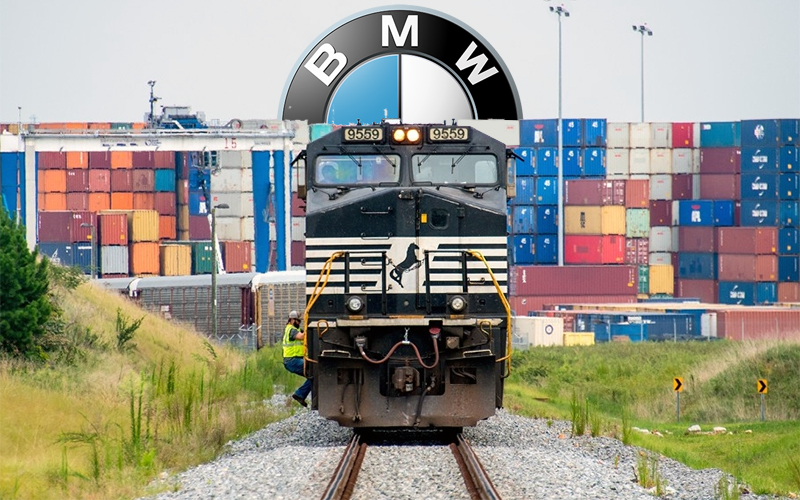BMW, South Carolina Ports & Norfolk Southern Collaboration Creates Unique Intermodal Solution

BMW’s collaboration with South Carolina Ports and Norfolk Southern creates a unique intermodal solution that eliminates truck moves, improves its sustainability efforts and subsequently spurs manufacturing efficiently in a growing region.
Auto manufacturers are on the bleeding edge of the movement toward cleaner cars, less pollution, and lower emissions.
In fact, BMW is proof that not only are its cars less polluting but so are its distribution processes.
The Munich, Germany-based automaker, which has a 1.8% market share in the United States, is one of the largest auto manufacturers in the world, selling 2 million cars in 2016 around the globe.
In its homeland, BMW has a 21% market share and 24% in the rest of Europe.
BMW’s Spartanburg, S.C., manufacturing plant is already the company’s largest final assembly plant in the world and employs more than 9,000. It recently underwent a $450 million expansion and has plans to hire up to an additional 1,000 workers. As a result of this working and hiring, the location now has the capacity to produce as many as 450,000 cars a year.
Some of those BMWs are sold domestically, but many are headed for overseas markets. And up until 2013, all of the parts and finished vehicles moved along crowded roads in the Interstate 26 corridor in South Carolina to get to and from the ports. This was an increasingly congested road that can be a bottleneck - a situation that presented a particular challenge as the volumes increased to and from the port.
Like many European-based companies, BMW thinks green - and it takes its stewardship of the environment seriously. Realizing the congestion and headaches that were created in the corridor, the company knew it needed to devise a better way to transport raw materials and finished goods. It needed to take trucks off the road, reduce emissions and put intermodal rail to work as a primary method of transport from the Port of Charleston inland.
“With our increasing output, it was our plan to devise a more efficient way to move containers in and out of the Port of Charleston,” says Alfred Haas, BMW’s department manager of material planning and transportation, explained. Haas, a 30-year veteran of BMW, knows the way company executives think and understands BMW’s primary and secondary goals.
“Our experts in Munich were making the case for taking trucks off the road,” says Haas. “So, not only are we looking to improve sustainability, we are also always looking for opportunities to save money.”
With the help of the Port of Charleston and the Norfolk Southern Railway, BMW did exactly that. In fact, how these entities collaborated is not only paying off for the automaker, but also for other manufacturers in the region as well - and, in turn, has earned this group a 2017 Alliance Award for innovative supply chain practices.
Let’s take a deep dive into the BMW’s transportation transformation and learn the details of its money-saving innovations that proved to be a vanguard for other South Carolina manufacturers.
Solving “Critical Mass”
The challenges addressed in early discussions among the eventual partners centered on the critical mass of manufactured exports originating in the upstate region of South Carolina. The central issue was how to create a more competitive transportation service to the Port of Charleston for those manufacturers in this growing region.
“The main responsibility was at the port,” says Haas. What BMW needed was a way to avoid the 204-mile journey from the Port of Charleston to its Spartanburg facility. “There was no inland port. They needed volume, and we had the volume.”
The Port of Charleston’s solution was the creation of an inland port on a 40-acre site in Greer, S.C., 212 miles away from its actual ocean port but close to BMW’s plant in Spartanburg. In addition, Norfolk Southern was a willing partner to take BMW’s trucks off the road.
Instead, the railway happily used containerized freight to serve Inland Port Greer through its main rail line along the Interstate 85 corridor between Charlotte and Atlanta where Norfolk Southern operates additional rail yards.
“The timing was right, the port was open to discussion, and Norfolk Southern was ready to go. It was a good way to get trucks off the road and on to rail, and to help BMW.”
Success Through Collaboration
As the three partners put their collective heads together, they arrived at three primary objectives of the project: More reliable and less expensive transportation services for export/import shippers between the South Carolina Upstate region and the port in Charleston; faster access to high population markets for shippers; and the conversion of a significant number of truck moves to rail in an effort to ease traffic congestion on I-26 while improving the industry’s environmental impact.
The growth of intermodal container movements in South Carolina and the region required the development of a state-of-the-art container handling facility in the state’s interior that’s able to be ground loaded and empty containers and leverage the efficiency and sustainability of rail transportation. Greer, which is located within 500 miles of nearly 100 million consumers in the Eastern U.S., proved to be ideal for overnight distribution.
At the beginning of the project in 2013, Inland Port Greer was expected to improve the movement of freight in the I-26 corridor by converting 50,000 all-truck container moves to more efficient multi-modal moves between the interior and the port within five years. It has exceeded that benchmark already - after only three years - and has proven to be a commercial game-changer for the partnership and the state of South Carolina.
From the port’s perspective, the Greer/BMW experience confirmed three necessary ingredients for a successful inland port project:
- a cargo base that supports the initial investment;
- a primary rail spine in a key corridor;
- and enough distance from the port that makes the truck vs. rail cost comparison work.
Inland Port Greer opened in October 2013, extending the Port of Charleston’s reach 212 miles inland and providing shippers with access to more than 95 million consumers within a one-day drive. The bottom line: Greer now boosts efficiency for international freight movements between the Port of Charleston and companies located across the Southeast.
In addition to BMW, the project has created additional economic investment in the South Carolina upstate, where Michelin and other international manufacturers already operate, and it has become attractive to companies wishing to become greener. In fact, the Environmental Protection Agency estimates companies can expect a 70% to 85% reduction in emissions from fewer truck/empty miles when moving to rail the way BMW did.
Overall, the rail service maximizes tonnage moved per gallon of fuel for importers and exporters, helping them save costs and lower their carbon footprint. The inland port adds the additional benefit of access to empty containers for regional shippers, who can now send trucks to Greer for the containers they need to move their goods.
“We took 25,000 trucks off the road in the first year,” says Haas. “It had obvious benefits right away, and the economics were right.” He adds that because of the outstanding collaboration among BMW, the port, and the railway, implementation of the changeover “was not difficult at all.”
Except for what Haas described as “a few hiccups at the beginning,” the changeover began in 2015. In all, it was about 30 months from initial planning to the first container moves. “It was a very smooth transition from road to rail,” he says. “We operate on a just-in-time basis for inventory, and it takes us about 90 minutes to unload a container of raw materials and get it in one of our warehouses. It’s an excellent network time frame.”
Every weekday, Norfolk Southern trains leave the Port of Charleston at 3:30 p.m. They arrive at Greer at 8:00 a.m. the next morning, just in time for distribution to warehouses and plants. For exports heading to the port, trains leave at 4:00 p.m. six days a week, available at the port for loading in 24 hours.
Drayage to and from the marine terminal is provided by the South Carolina Ports Authority’s RapidRail trucker dispatch or the ocean carriers. Import RapidRail boxes are moved to rail within 24 hours of becoming available or released by Customs. With proper coordination, RapidRail boxes can be moved to rail the same day as being offloaded from the vessel.
Collaboration in Hard Numbers
Besides the immeasurable effects of cleaner air and less crowded highways, BMW has enjoyed manufacturing synergies from the inland port arrangement as well. Haas says that production is at an all-time high, partially as a result of the new distribution pattern.
BMW’s imported inbound containers jumped from 1,218 in 2013 to 15,408 last year. From 2015 to 2016, imported containers jumped 1%, while export containers jumped 44% for an overall year-over-year growth rate of 25%.
But it’s not just BMW’s containers - even though it was the automaker who was the catalyst to this arrangement. Overall inbound containers jumped from 1,643 in 2013 to 51,797 last year. From 2015 to 2016, imported containers jumped 37%, while export containers jumped 39%, for an overall year-over-year growth rate of 38%.
The benefits of the project have been numerous for all of the partners involved. Although BMW remains the largest single user of the inland port, more than 150 other exporters and importers (Eastman Chemical, Adidas, Belk, just to name a few) have discovered the benefits of Inland Port Greer and regularly use the facility.
“At the beginning, we were the only one using Inland Port Greer,” says Haas. “Now we are about half of its volume. It really took off.” In fact, there were 75,000 rail moves handled by the facility and Norfolk Southern in 2016.
Based on the feedback and the hard numbers, South Carolina Ports officials have called Inland Port Greer “a clear winner.” It has improved port service for key manufacturing customers in the upstate region, and it’s been an effective tool for capturing discretionary freight beyond the port’s traditional markets.
However, the catalyst was BMW, whose significant volume commitment - both imports and exports - provided the necessary critical mass for the start-up. BMW officials say the port and the railroad deserve “kudos” as for their assistance in this successful supply chain collaboration effort.
“It was mostly about a positive business case that also had a positive environmental effect,” adds Haas. “We have a good relationship with the service providers, and collaboration is the most important thing to make it work on the timeline we agreed to. It’s been a very smooth process.”
The Alliance Awards
The successful partnership forged by BMW, South Carolina Ports and Norfolk Southern Railway was awarded a 2017 Alliance Award. The Alliance Awards, sponsored by Logistics Management and SMC³, recognize how shippers and their service providers work together to overcome challenges to critical components of their unique supply chains. Winners are commended for their ability to solve challenges through innovative, measurable means.
Entries for the 2018 Alliance Awards awards are being accepted here.
Related Article: Carolina Connector Intermodal Rail Terminal
Intermodal Rail White Papers & Case Studies
Intelligence & Integration in Intermodal Logistics
Logistics Planner, powered by Quintiq’s world record-breaking optimization technology, became the answer to increased visibility and control for Van den Bosch Transporten’s planners. Download Now!
Adding Intermodal to Your Portfolio
As increased over-the-road regulations are set to go into effect in 2017, supply chain managers should take steps to prepare today in order to protect their organizations from negative impact. Download Now!
The X’s and O’s of Intermodal Rail in Supply Chain Management
As the coach of your supply chain, you have the opportunity to turn to your playbook and choose from multiple transportation modes to maximize the efficiency of your freight network. Download Now!
The Intermodal Rail Bracketology Guide
Learn how to identify sub-optimal full-truckload freight that is vulnerable to capacity constraints if and when a supply chain disruption occurs. Download Now!
Practical Steps for Highway to Intermodal Rail
Learn how to increase access to capacity, reduce transportation costs and mitigate exposure to future trucking regulations. Download Now!
Transportation Management Systems & Intermodal Rail
An interactive, personalized guide to learn more about the combined benefits of a TMS and intermodal rail. Download Now!
Highway to Intermodal Rail (H2R) Conversions Deliver Bottom Line Results
CSX Transportation has found that 96% of shippers have sub-optimized freight in their network. Does your organization? Find out and learn how to address sub-optimized freight in your supply chain. Download Now!
More SC24/7 Intermodal Papers
Article Topics
Norfolk Southern News & Resources
Norfolk Southern announces preliminary $600 million agreement focused on settling East Palestine derailment lawsuit STB Chairman Oberman takes activist investor Ancora to task for its attempt to take over Norfolk Southern One-year past Norfolk Southern East Palestine derailment, Cantwell calls for passage of Railway Safety Act Canadian National and Norfolk Southern are set to launch a new domestic intermodal service NS President and CEO Shaw testifies before Senate EPW Committee on East Palestine train derailment FRA announces plan to conduct safety assessment of Norfolk Southern’s operations Norfolk Southern rolls out six-point plan focused on safety operations More Norfolk SouthernLatest in Transportation
Baltimore Bridge Collapse: Impact on Freight Navigating Amazon Logistics’ Growth Shakes Up Shipping Industry in 2023 Nissan Channels Tesla With Its Latest Manufacturing Process Why are Diesel Prices Climbing Back Over $4 a Gallon? Luxury Car Brands in Limbo After Chinese Company Violates Labor Laws The Three Biggest Challenges Facing Shippers and Carriers in 2024 Supply Chain Stability Index: “Tremendous Improvement” in 2023 More Transportation























